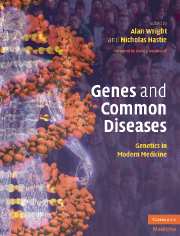Book contents
- Frontmatter
- Contents
- List of Contributors
- Foreword
- Section 1 Introductory Principles
- 1 Genes and their expression
- 2 Epigenetic modification of chromatin
- 3 Population genetics and disease
- 4 Mapping common disease genes
- 5 Population diversity, genomes and disease
- 6 Study design in mapping complex disease traits
- 7 Diseases of protein misfolding
- 8 Aging and disease
- 9 The MHC paradigm: genetic variation and complex disease
- 10 Lessons from single gene disorders
- 11 Environment and disease
- 12 Contemporary ethico-legal issues in genetics
- Section 2 Common Medical Disorders
- Index
- References
12 - Contemporary ethico-legal issues in genetics
Published online by Cambridge University Press: 17 August 2009
- Frontmatter
- Contents
- List of Contributors
- Foreword
- Section 1 Introductory Principles
- 1 Genes and their expression
- 2 Epigenetic modification of chromatin
- 3 Population genetics and disease
- 4 Mapping common disease genes
- 5 Population diversity, genomes and disease
- 6 Study design in mapping complex disease traits
- 7 Diseases of protein misfolding
- 8 Aging and disease
- 9 The MHC paradigm: genetic variation and complex disease
- 10 Lessons from single gene disorders
- 11 Environment and disease
- 12 Contemporary ethico-legal issues in genetics
- Section 2 Common Medical Disorders
- Index
- References
Summary
Introduction
Since the inception of the current “genetic age” and its characterization as having created a “risk society”, the ethical and legal debate surrounding the regulation of genomics (genetic research and related biotechnology and clinical genetics) has largely been informed by evaluations of risk. These risks pertain to individuals, populations, future generations and the environment. Cutting across these cohorts, the not unsubstantial risks of genetic relativism and determinism have excited concerns about genetic discrimination, triggered debates about the place and form of justice in the modern (genomic) health context, and challenged the practical realization and protection of human rights, individually, internationally and inter-generationally.
As evidenced by the papers which make up this volume, genomic knowledge is accumulating at an impressive, if not unparalleled rate. What is also evident, however, is that our comprehension of genomics remains somewhat rudimentary, particularly when it comes to understanding the interactions that occur between genes, and between genes and the environment. Further, while numerous genetic tests have been developed, we have been less successful at devising effective genetic therapies and treatments. That is not to say that genomics is a purely “frontier” science. On the contrary, it is becoming more and more a part of regular clinical practice, most particularly in the developed world. It has been claimed that there is:
… a transition [occurring] from traditional medical genetics, which focuses narrowly but effectively on heritable conditions, to genomic medicine, which integrates genetic information into everyday clinical practice. Indeed, according to proponents of genomic medicine, it is knowledge that will transform medical practice in the long-term – knowledge of how genes interact with each other and with the environment to cause disease
(WHO, 2005).- Type
- Chapter
- Information
- Genes and Common DiseasesGenetics in Modern Medicine, pp. 176 - 198Publisher: Cambridge University PressPrint publication year: 2007



